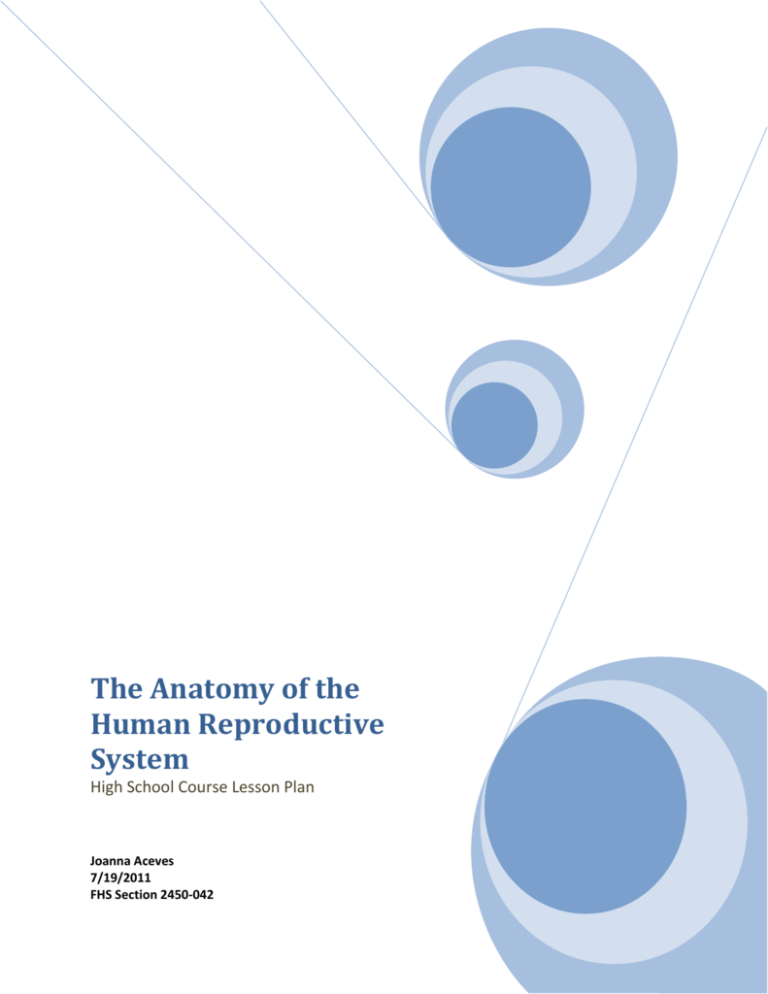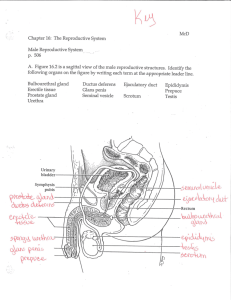The Anatomy of the Human Reproductive System
advertisement

The Anatomy of the Human Reproductive System High School Course Lesson Plan Joanna Aceves 7/19/2011 FHS Section 2450-042 Human Reproductive Anatomy Introduction Understanding the anatomy of the reproductive organs is a base for the introduction of sexuality. Knowledge of proper terminology and function will facilitate the discussion on of the physical role each body plays in sexual and reproductive activity. The lesson plan will cover the male and female anatomy as well as the functions they serve. Activities will reinforce the material covered and allow the student to interact with their peers and parents about subject matter that should be openly discussed. Objectives The lesson objective is to familiarize students with the basic development, function and terminology of both the male and female reproductive systems. The outline will cover general areas of discussion as well as topics of interest to be presented in informative, yet open manner. The students should be encouraged to interact in a respectful and appropriate manner. Lesson should be broken up into individual days per gender, this will allow amply time for questions and discussion on subject matter as well as avoid overwhelming students. 1 Outline Embryology The embryo begins to distinguish between male and female in the 9th week of development The same embryonic bodies form genitals for both sexes o Mesoderm The process will continue until the 20th week, when sex can be determined by ultrasound System Similarities Both systems are dormant until puberty Primary sex organs, gonads, produce gametes o Ovaries; 1 released per month o Testies; 100,000,000 produced per day Accessory reproductive organs used for sexual intercourse Autonomic nervous system stimulates arousal and climax o Clitoris o Glans of Penis Protection of reproductive organs o Labia Majora o Scrotum Secretion of mucin for lubrication o Vestibular glands o Bulbourethral glands Anatomy of the Female Reproductive System External Structures (vulva) o Mons Veneris Mound of Venus Fatty tissue pads between the pubic bone and skin Grows hair at puberty o Labia Majora Outer lips Begin next to the thigh and extend inward Encase labia minora and urethral opening o Labia Minora Inner lips Hairless Join at the clitoral hood and extend downward Contain sweat and oil glands, blood vessels and nerve endings General size and length varies with each individual; there is no standard 2 o Clitoris o Vestibule o o Consists of shaft (length between glans and body), glans(head housing high concentration of nerve endings)and the crura(tip of cavernous body) Cavernous bodies engorge with blood during arousal Clitoris will increase in size closer to ovulation Same nerve ending concentration as the head of a penis Only purpose is for sexual pleasure Area inside the labia minora Sensitive to touch Houses the urinary and vaginal openings Urethral opening Excretion site of urine from the bladder Introitus Opening of the vagina Located between the anus and the urinary opening Partially covered by the hymen, this tissue usually present at birth Skin between the vaginal opening and the anus Perineum Mid structures o Vestibular bulbs Arousal causes bulbs to fill with blood making the vagina lengthen and vulva to swell Analogues to spongy tissue in the penis o Bartholin’s glans Located on each side of the vaginal opening Secrete a few drops of liquid during sexual arousal Internal Structures o Vagina Opening that leads into the body, towards the small of the back Composed of 3 tissue layers Mucous-produce secretions that help maintain chemical balance Muscle-concentrated around vaginal opening Fibrous- involved in vaginal contraction and acts as connective tissue to other pelvic structures Grafenberg Spot is a system of glands and ducts analogues t the prostate gland o Cervix Located at the back end of the vagina Secrets mucus Opening of the cervix is called the os 3 o Uterus Womb Hollow, tear drop shaped Endometrium Inner layer of uterus Nourishes zygote Produces hormones o Fallopian Tubes Consists of 2 four-inch tubes from the uterus to the ovaries Fimbriae cover the ovaries Cilia in tubes carry egg for fertilization o Ovaries Consists of 2 almond shaped structures at the end of the fallopian tubes Produce sex hormones Estrogens are involved in physical sex characteristics and help regulate menstrual cycles Progesterone help regulate menstrual cycle and promote maturing of uterine lining in preparation for pregnancy Ovulation is the release of a mature egg Anatomy of the Male Reproductive System External Structure o Penis Made of spongy tissue, fibrous tissue, nerves and blood vessels Root extends in the pelvic cavity Shaft includes external portion to the end of the head Glans refers to the head 2 cavernous bodies run parallel above the single spongy body Large concentration of blood vessels When sexually excites, all 3 fill with blood causing an erection Skin is usually hairless Foreskin covers the head Circumcision is the surgical removal of the foreskin The corona is a rim around the glans portion of the penis The frenulum is connective tissue that holds the shaft to the glans on the underside of the penis Internal Structures o Scrotum Also known as scrotal sac Pouch of skin that forms a pocket of the abdominal wall directly below the penis Outer layer is dark skin , may have hair. Inner layer is muscle fiber and connective tissue 4 o Testes o o o Secrete sex hormones called androgens Most common is testosterone Produce sperm Seminiferous tubules aid in production and storage Epididymis stores sperm while they mature; inactive at this stage Vas Deferens Drain sperm from epididymis to spermatic cord Sperm travel from vas deferens to the ejaculatory duct(also formed by seminal vesicles) where they enter the urethra for ejaculation Seminal Vesicles o Two separate compartments house the testes Spermatic cords suspend the testes as well as house the vas deferens (tubes that carry sperm) Cremasteric muscles can contract, causing upward movement of the testes. Sensitive to temperature changes Small glands that follow the vas deferens Secrete fluid that will protect and nourish sperm(about 70% of seminal fluid) Prostate Gland Located at the base of the bladder Secretes final 30% of seminal fluid Both ejaculatory ducts and urethra pass through the prostate Alkaline fluid helps counteract the acidity of the male urethra Cowper’s Gland Also known as the bulbourethral glands Located on each side of the urethra Connected to urethra by small ducts Secrete mucus-like substance at sexual arousal May contain active sperm 5 Discussion Topic Why are we so prone to using nicknames for our body parts? Discuss advantage of proper terminology and how it decreases confusion. Open up discussion about what terms individuals grew up with for certain structures and what is popular in our culture. How much of the information was new to you? Has the information been covered in other classes? Have parents been proactive about providing information? Stress that this is not taboo information but basic human anatomical understanding. How does the media affect your perception of what is a “standard or desired” body” Individual variances are normal, not everyone will look or function the same. Expectation to meet the standards set by other is unhealthy and can be harmful to our own general health. We should be respectful of our individuality. 6 Class Activities Anatomical Drawings The instructor should read a description or the structure and students must properly name and draw the structure. This could be used as a quiz to make sure students study hand outs and memorize proper terminology. Follow the path from gamete production to child birth Start from the production of sperm and egg and follow the path to fertilization to fetus to birth. This activity will allow the flow through both bodies to be followed a swell as give a more functional picture of the organ system. Having the students discuss the process will allow them to interact as well as help one another to understand the process. Labeling Have students label the provided worksheets 7 Female Anatomy 8 Female Anatomy 9 Male Anatomy 10 Male Anatomy 11







